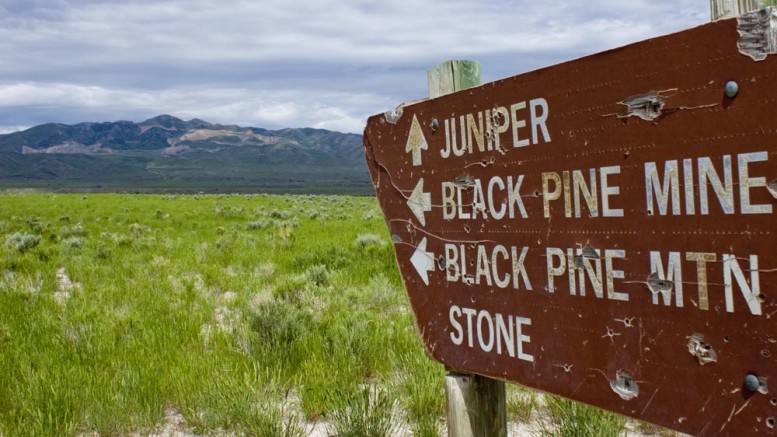New drill results from Liberty Gold’s (TSX: LGD; US-OTC: LGDTF) wholly owned Black Pine project in Idaho include high-grade intervals of Carlin-style oxide gold mineralization.
Drilling has also expanded the project’s mineralized footprint by linking the Discovery 2 and Discovery 3 zones for a combined width of 400 metres and a strike length of 300 metres.
The Discovery 2 zone, which was unearthed in July, is open in all directions and continues to deliver thick, high-grade oxide gold intercepts along a north-striking feeder fault corridor, as well as long intervals of gold mineralization in the footwall area to the east.
“It is our best asset in the company at this point, based on the initial 69 drill holes that we have released,” says Cal Everett, Liberty Gold’s president and CEO. “It’s just the grade and thickness of those intercepts, and how laterally continuous they seem to be.”
Everett says that Black Pine hosts a multimillion-ounce gold system that can be recovered through low-cost, open-pit mining and heap leaching, as the intercepts lie below thick intervals of moderate-grade mineralization.
Assays from the five latest drill holes in the Discovery 2 zone included hole 64, which returned 3.4 grams gold per tonne over 63 metres from a downhole depth of 113 metres, along with 5.01 grams gold over 34 metres from 142 metres, and 6.21 grams gold over 21 metres from 146 metres.
Hole 66 intercepted 1.15 grams gold over 70 metres from 174 metres, including 2.92 grams gold over 15 metres from 175 metres, and 14.7 grams gold over 2 metres from 181 metres.
Other highlights were 2.38 grams gold over 21 metres from 229 metres, including 4.89 grams gold over 9 metres from 238 metres in hole 68, and 1.52 grams gold over 58 metres from 160 metres, with 7.42 grams gold over 9 metres from 174 metres and 12.2 grams gold over 5 metres from 177 metres in hole 69.
Most intercepts to date are oxide, and Everett says he hopes to get the metallurgy done in the first half of next year.
The company says that the area tested to date represents a small part of the Discovery 2 zone’s total strike length. “We have only drilled 30% of the first square kilometre of the 12 sq. km oxide system,” Everett says.

Drillers at work in the Discovery 1 zone at Liberty Gold’s Black Pine gold property in early 2019. Credit: Liberty Gold.
“We found that there is a really strong, high-grade portion to the deposit that is extremely material to anybody who puts this into production, because that is early payback material to pay off your capex as soon as possible, and you have got a long-life, big-ounce producer for a long time,” Everett says, adding that the company has drilled deeper on average than previous operators.
From 1963 until the mid-1990s, operators explored various parts of the Black Pine property. Of 1,900 historic drill holes, 1,400 still contain unmined gold intercepts. Liberty Gold compiled the best 500 of them, including its own drilling to date, and found that eight of the top-10 and 13 of the top-20 intercepts — measured by average grade multiplied by intercept length — were results generated by their own drilling.
“Our drilling compares very favourably to that of past operators,” says Moira Smith, Liberty Gold’s vice-president of geoscience and exploration.
The company is targeting a minimum resource of 2 million oz. before putting out a maiden resource estimate for the project.
Current drilling focuses on extending the strike length through a 300-metre gap between the Discovery 2 zone and mineralization associated with the historic B pit to the south. The Discovery 1 and Discovery 2 zones are projected to converge near the northern margin and below the historic B pit, which had an average historic mined grade of 1.38 grams gold per tonne.
Smith says drilling will continue until mid-December, weather permitting. The company plans to double the drill rate by adding a night shift to the two reverse-circulation drill rigs that operate within the 1 sq. km area between the historic A pit, B pit and the A basin target.
“We really do think this is going to be the next big thing,” Smith says.
The Black Pine gold project hosts a Carlin-style, sediment-hosted gold deposit in southern Idaho’s Cassia County, 29 km northwest of the nearest town of Snowville, Utah.
The property hosts the Black Pine mine, which produced 435,000 oz. gold from five shallow pits between 1992 and 1997.
The company acquired the Black Pine project from Western Pacific Resources (TSXV: WRP) in June 2016 for US$800,000 in cash, 300,000 Liberty shares, and a 0.5% net smelter return reserved to Western Pacific.

An aerial view looking south across the Discovery 1 and 2 zone drill sites, with two rigs drilling on the Discovery 2 zone above a historic pit at Liberty Gold’s Black Pine gold project in southern Idaho. Credit: Liberty Gold.
Black Pine’s large and shallow Carlin-style gold system is similar to the company’s Goldstrike project in Utah. The Goldstrike property hosts the Goldstrike heap-leach mine, which produced 209,000 oz. gold from 12 shallow pits at an average grade of 1.2 grams gold per tonne between 1988 and 1994.
“With more successful drilling, we see Black Pine potentially eclipsing Liberty’s Goldstrike property as the company’s flagship project,” says Mick Carew, an analyst at Haywood Securities, noting that drilling at Black Pine shows oxide grades that are higher than the average grades at the Goldstrike project.
Brock Salier, a partner at Sprott Capital Partners, describes the project as “one of the highest-margin, undeveloped Carlin assets, and the one oxide-only project.”
National Bank of Canada analyst John Sclodnick says he expects “to continue to see results showing the potential for a highly economic mine, with two drill rigs continuing to operate.”
Liberty’s project portfolio includes the Kinsley gold project, 150 km northeast of Ely, Nev.; the TV Tower high-sulphidation epithermal and porphyry gold-copper property in northwestern Turkey; the Halilaga copper-gold porphyry project, located 20 km southeast of TV Tower; and a pipeline of early-stage exploration projects in Nevada.
The company’s key shareholders include Van Eck, with 10.1%; Resource Capital Funds, with 7.3%; Newmont Goldcorp (TSX: NGT; NYSE: NEM), with 5.8%; and Teck Resources (TSX: TECK:B; NYSE: TECK), with 3.3%. Fifteen other funds own 17%, and management owns 6.8%.
At press time, Liberty Gold was trading at 85¢ in a 52-week range of 29¢ to $1 per share.
Haywood’s Carew has a “buy” rating on the stock and a $1.60-per-share price target. Sprott’s Salier has a buy rating and a $1.05-per-share price target, while National Bank’s Sclodnick has an “outperform” rating and a $1-per-share target price.
The company has 237 million common shares outstanding for a $201-million market capitalization.




Be the first to comment on "Liberty Gold hits high-grade gold at Black Pine"